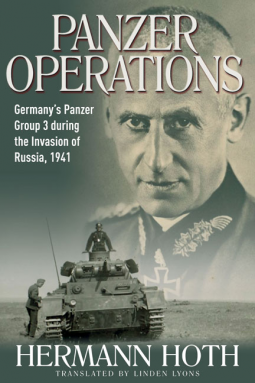
PANZER OPERATIONS
Germany's Panzer Group 3 During the Invasion of Russia, 1941
by Herman Hoth, Translated by Linden Lyons
This title was previously available on NetGalley and is now archived.
Send NetGalley books directly to your Kindle or Kindle app
1
To read on a Kindle or Kindle app, please add kindle@netgalley.com as an approved email address to receive files in your Amazon account. Click here for step-by-step instructions.
2
Also find your Kindle email address within your Amazon account, and enter it here.
Pub Date Apr 23 2015 | Archive Date May 04 2015
Casemate Publishing | Casemate Publishing
Description
This book, originally published in German in 1956, has now been translated into English, unveiling a wealth of both experiences and analysis about Operation Barbarossa, perhaps the most important military campaign of the 20th century.
Hermann Hoth led Germany’s 3rd Panzer Group in Army Group Center—in tandem with Guderian’s 2nd Group—during the invasion of the Soviet Union, and together those two daring panzer commanders achieved a series of astounding victories, encircling entire Russian armies at Minsk, Smolensk, and Vyazma, all the way up to the very gates of Moscow.
This work begins with Hoth discussing the use of nuclear weapons in future conflicts. This cool-headed post-war reflection, from one of Nazi Germany’s top panzer commanders, is rare enough. But then Hoth dives into his exact command decisions during Barbarossa—still the largest continental offensive ever undertaken—to reveal new insights into how Germany could, and in his view should, have succeeded in the campaign. Hoth critically analyses the origin, development, and objective of the plan against Russia, and presents the situations confronted, the decisions taken, and the mistakes made by the army’s leadership, as the new form of mobile warfare startled not only the Soviets on the receiving end but the German leadership itself, which failed to provide support infrastructure for their panzer arm’s breakthroughs. Hoth sheds light on the decisive and ever-escalating struggle between Hitler and his military advisers on the question whether, after the Dnieper and the Dvina had been reached, to adhere to the original idea of capturing Moscow. Hitler’s momentous decision to divert forces to Kiev and the south only came in late August 1941. He then finally considers in detail whether the Germans, after obliterating the remaining Russian armies facing Army Group Center in Operation Typhoon, could still hope for the occupation of the Russian capital that fall.
Hoth concludes his study with several lessons for the offensive use of armored formations in the future. His firsthand analysis, here published for the first time in English, will be vital reading for every student of World War II.
A Note From the Publisher
PLEASE NOTE THIS FILE AVAILABLE FOR FREE DOWNLOAD IS A PDF- NOT A KINDLE FILE, AND IT MAY NOT WORK WITH CERTAIN KINDLE DEVICES, AS IT IS NOT A KINDLE FILE.
WE DO NOT OFFER KINDLE FILES FOR FREE DOWNLOAD.
KINDLE FILES WILL BE FOR SALE VIA AMAZON.COM
Advance Praise
No Advance Praise Available
No Advance Praise Available
Marketing Plan
• Trade, library and direct-audience review mailing to local, regional and national
publications
• Catalog and website advertising
• Direct-mail and internet promotion
• Simultaneous launches in the US and UK
• Sales presentations to all major chain stores, select local bookstores, national catalog
booksellers and book clubs
Available Editions
| EDITION | Hardcover |
| ISBN | 9781612002699 |
| PRICE | $32.95 (USD) |





